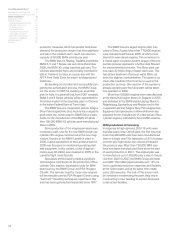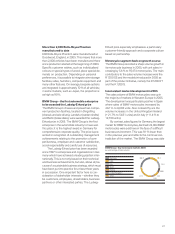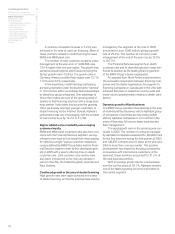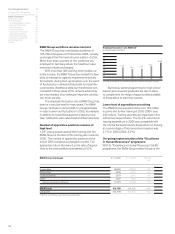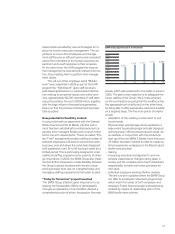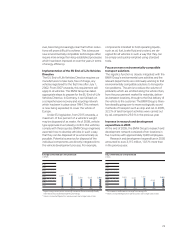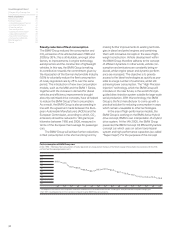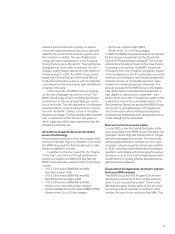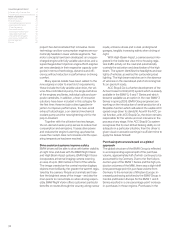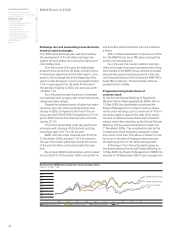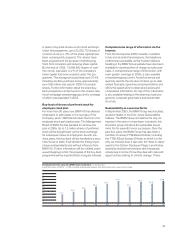BMW 2005 Annual Report Download - page 31
Download and view the complete annual report
Please find page 31 of the 2005 BMW annual report below. You can navigate through the pages in the report by either clicking on the pages listed below, or by using the keyword search tool below to find specific information within the annual report.
30
Steady reduction of fleet consumption
The BMW Group reduced the consumption and
CO2emissions of its vehicles between 1990 and
2005 by 30%; this is attributable, amongst other
factors, to improvements in engine technology,
aerodynamics and the construction of lightweight
vehicles. In this way, the BMW Group is making
its contribution towards the commitment given by
the Association of the German Automobile Industry
(VDA) to voluntarily reduce the fleet consumption
of newly registered cars by 25% over the same
period. The introduction of new low-consumption
models, such as the MINI and the BMW 1 Series,
together with the increase in demand for diesel
vehicles and efficiency improvements brought
about by optimised drive concepts, have all helped
to reduce the BMW Group’s fleet consumption.
As a result, the BMW Group is also proceeding in
line with the agreement made between the Euro-
pean Automobile Manufacturers (ACEA) and the
European Commission, according to which, CO2
emissions should be reduced to 140 grams per
kilometre between 1995 and 2008, measured in
terms of the European fleet average for passenger
cars.
The BMW Group will achieve further reductions
in fleet consumption in the short and long term by
making further improvements to existing technolo-
gies in diesel and petrol engines and combining
them with innovative concepts in the area of light-
weight construction. Vehicle development within
the BMW Group therefore adheres to the concept
of efficient dynamics. In other words, vehicle con-
sumption and emissions are constantly being re-
duced, whilst engine power and dynamic perform-
ance are increased. The objective is to provide
access to the latest technologies as quickly as pos-
sible to a large number of customers, whilst still
achieving lower consumption. The “High Precision
Injection” technology, which the BMW Group will
introduce in the near future, is the world’s first jet-
guided direct injection system suitable for large-scale
serial production. With this technology, the BMW
Group is the first manufacturer to come up with a
practical solution for reducing consumption in ways
which remain unavailable to other technologies.
In the area of high-performance models, the
BMW Group is working on the BMW Active Hybrid
drive concept, BMW’s own interpretation of a hybrid
drive system. At the IAA 2005, the BMW Group
presented the BMW Concept X3 EfficientDynamics
concept car which uses an active transmission
system and high-performance capacitors (so-called
“Super Caps”). For the purposes of the concept
90
*The adoption of the uniform VDA computation method for measurement in accordance with the DIN-1/3-Mix (up to 1996) and the New European Driving Cycle
(from1997 onwards) gives rise to minor variances compared to earlier BMW Group annual reports.
91 92 93 94 95 96 97 98 99 00 01 02 03 04
100.0 97.5
90.9 89.3
85.8 83.7 86.3 87.3 85.6
79.6
74.0
74.3 74.0
05
70.8
77.3
Fuel consumption of BMW Group cars
(Index:1990 =100; Basis: fleet consumption of newly registered cars measured on the basis of the New European Driving Cycle in accordance with the VDA
commitment for passenger/estate cars*)
110
105
100
95
90
85
80
75
70
65
82.1
Group Management Report 8
A Review of the Financial Year 8
The General Economic Environment 11
Review of operations 15
BMW Stock in 2005 38
Financial Analysis 41
--Internal Management System 41
--Earnings performance 42
--Financial position 45
--Net assets position 46
--Subsequent events report 49
--Value added statement 49
--Key performance figures 51
--Comments on BMW AG 52
Risk Management 56
Outlook 60


